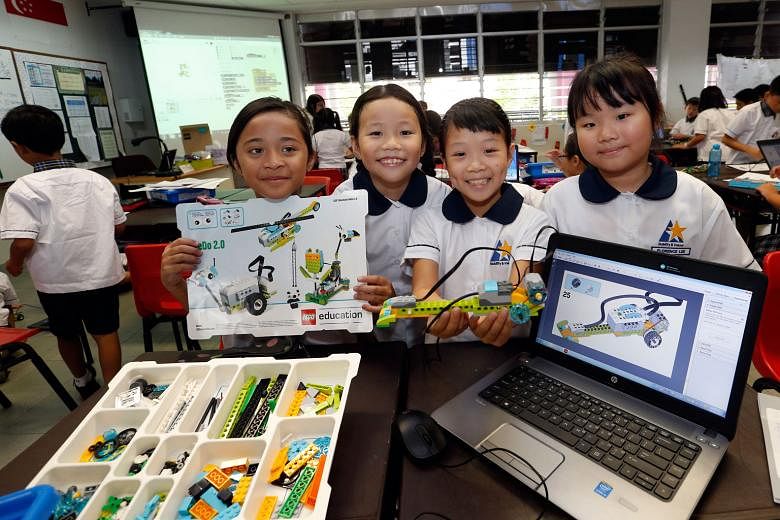Once a week, Nurul Insyirah Jamaludin, nine, tinkers with an assemblage of Lego bricks, motors and sensors with her classmates to design a robotic toy.
After building, say, a race car, they would combine blocks of pre-written computer codes using a laptop to instruct the toy to react to specified stimuli. For instance, the car can be programmed to move at a certain speed or stop when it approaches an obstacle.
The Primary 3 pupil at North View Primary School enjoys the Code for Fun lessons, which have been incorporated into the school's curriculum time for Primary 3 and 4 pupils since January.
-
READ MORE

"We build a toy and it comes alive," said Nurul, beaming with excitement.
The Code for Fun programme was introduced in June last year by the Infocomm Development Authority (IDA) as an enrichment for Ministry of Education schools. Since then, 117 primary and secondary schools have rolled out the scheme, and 34,000 students - some as young as seven years old - have signed up.
Students spend 20 hours within a year to complete the programme, which has different tasks and challenges, depending on the level.
The programme is a result of a larger, multi-pronged strategy by the Government to plug the technology manpower gap here.
Data from IDA, which tracks and trains technology manpower in Singapore, shows that about 15,000 technology job vacancies could not be filled in 2014. About half of these were for software developers.
More tellingly, Singapore is expected to find itself short of a total of 30,000 technology specialists - including some 11,000 software developers - by next year.
Code for Fun aims to infuse computational and logical thinking in children. Another similar, recent move involved secondary schools. Last month, 19 schools, out of over 160 here, said they will offer computing as a new O-level subject to Secondary 3 students from next year.
"We aim to develop students into critical thinkers and innovators who can help drive the country's vision of becoming a smart nation," said IDA assistant chief executive Khoong Hock Yun.
"At the same time, this will ensure that we have a ready pool of tech talent, equipped with skills of the 21st century to take on jobs, such as in software development, cybersecurity and data analytics, that will be in demand," he said.
DEMAND FOR TECH WORKERS CONTINUES TO GROW
Demand for software engineers and developers will come from both the public and private sectors.
Many tech firms like Google and Facebook have based their Asian operations in Singapore. Some are hiring aggressively here. In January, Google said on its website that it plans to set up "a large engineering presence in Singapore".
Last month, the Government announced plans to hire 1,000 engineers, including programmers, by this year to expand the existing pool by more than 13 per cent.
Mr Khoong believes technology is no longer a back-office function but a strategic tool as companies and services go digital.
"The ability to embrace and apply disruptive technologies becomes critical for all companies to remain relevant in the future economy," he said.
Data analytics tools are an example of disruptive technology. They allow companies to mine customer information, such as spending behaviour, for targeted marketing.
Increasingly, non-tech firms find that they need to hire technology workers as more services go digital. For instance, over one-quarter of financial services giant Goldman Sachs' 33,000 full-time staff are engineers and programmers.
"In short, every company is now a tech company with its own stable of programmers, data analysts and other tech specialists," said Mr Khoong.
OBSTACLES
According to human resource experts, one reason many young Singaporeans are not keen to strive for a career in software development is the perception that such jobs are low-level grunt work that attracts little recognition and has a stunted career progression.
"People picture a software developer as someone hammering out lines of codes in a cold, quiet room at the back of the office," said Ms Linda Teo, country manager at ManpowerGroup Singapore.
"It is a sad stereotype," she said, adding that most takers for software development positions are from Malaysia and India.
Software development positions also do not pay as well as the more popular IT project management roles. According to the latest 2014 Manpower Ministry data, the median salary of IT project managers was $8,300, about twice that of a software developer.
SOLVING THE PROBLEM
However, the scenario is changing. Graduates from the Nanyang Technological University's business and computing double-degree programme reportedly had the highest pay jump of 33 per cent last year among their peers, putting their salaries almost on a par with those who studied law or medicine at other universities.
Last month, Deputy Prime Minister Teo Chee Hean announced that the Government would review the salaries of public-sector engineers and start a leadership scheme to groom them for positions such as chief engineer, chief technologist and chief scientist.
The review will also apply to public-sector software developers. IDA said it is looking into raising the salaries of software engineers to make them on a par with those of their peers on the management track.
More details will be announced during the Committee of Supply debate next month.
National Trades Union Congress assistant secretary-general Patrick Tay believes it is important that locals fill these software development roles. He said: "New software development openings will be in fields such as e-commerce, financial technology, big data, security, gaming and animation. They are strategic to Singapore's future economy."
Lecturer David Chin, 45, said programmes like Code for Fun should be included in the school curriculum at all levels for it to see results. "Programming will be the next engineering," he said.


